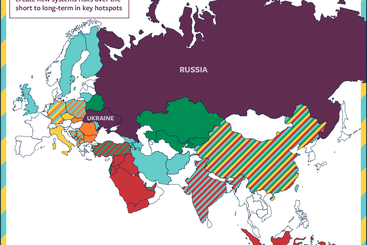What do you do when your neighbour is fighting? This article explores the impact of the ongoing war in Ukraine on the economy of Kazakhstan, which shares the world’s largest border with Russia.
The war in Ukraine is affecting the world in a number of ways. Higher commodity prices are pushing inflation up, investment uncertainty is tightening global financial conditions, and supply chains are disturbed. Russia’s neighbours are feeling some consequences from the war: they may experience a fall in global investor interest in the region due to increased geopolitical risks, while the reallocation of business from Russia and Belarus may boost foreign direct investment flows at least in the short run. Because of their close trade links, neighbouring countries like landlocked Kazakhstan are experiencing changes in trade and disrupted supply chains, thus adversely affecting inflation and economic growth.
Disrupted supply chains and transit
The outbreak of war in Ukraine has severely affected supply chains in Kazakhstan, which counts both Russia and Ukraine as trading partners. Difficulties obtaining inputs due to sanctions in Russia, and disrupted supply chains, are causing delays in Kazakhstan’s manufacturing sector. Despite these problems, the sector bounced back in August after a sharp dip in March. This may indicate that companies have been able to recalibrate their supply chains or find alternative inputs.
Many multinational companies that were based in Russia and Belarus before the war, such as Japanese Marubeni and the US-headquartered inDrive, have expressed willingness to relocate their businesses to Kazakhstan and neighbouring Central Asian countries. While this potential increase in foreign direct investment is likely to benefit the economy, it is not certain if this shift is short term or long term - added to which, other companies are now looking at the entire region with more caution, due to the increased geopolitical risks involved.
As well as supply chains, the war has affected trade and transit corridors in the region. The Caspian Pipeline Consortium (CPC), which goes through the Russian Black Sea port Novorossiysk, had been subject to several disruptions since the beginning of the year, with the Russian side citing accidents and environmental regulations. This has critical implications outside the region, because the CPC is the official export route to Europe and one of the world's largest pipelines. In 2021, the pipeline exported up to 1.3 million barrels per day (bpd) of Kazakhstan's main crude grade blend (54 million tonnes in total), which represented 80% of Kazakhstan's total oil production of 1.6 million bpd. During nine months of 2022, oil exports increased mainly due to high export prices and a 1.6% increase in volume, but a more prolonged closure of CPC could have extremely negative consequences for Kazakhstan’s exports and current account. However, from January 2023, 1.5 million tonnes of oil will be shipped through the alternative oil route via the Caspian Sea “Baku-Tbilisi-Ceyhan” pipeline. The new route’s volume is expected to increase to around 6 to 6.5 million tonnes of oil in the long run, which would still not make up for lost CPC capacity - but it is still a good opportunity reduce Kazakhstan’s dependence on the CPC.
CPC is a part of the Middle Corridor, or Trans-Caspian International Transport Route (TITR), a multilateral institutional development linking China’s rail freight transport networks and the European Union through Central Asia, the Caucasus, Turkey, and Eastern Europe. Its significance is rising as the trade in the region has been affected by the war in Ukraine and difficulties with the transit routes through Russia.
Growing value of exports, growing inflation
The Russian war in the Ukraine has had a positive impact on the value of Kazakhstan’s exports. From January to September 2022, exports from Kazakhstan amounted to $65.8 billion, 47.5% higher than in the same period of 2021. This was largely explained by the increase in commodity prices, with only a marginal increase in the volume of exports itself. Exports from Kazakhstan to Russia demonstrated 16% growth, reaching $5.9 billion during the first nine months of 2022, while imports increased only marginally by 3%, up to $12.4 billion. The share of steel and steel products went down by 20.7% year on year from 1.3 to 1.0 million tons (from $1.2 billion to $0.8 billion) as of the end of October 2022, whereas the export of smartphones has increased from $37k to $78 million during the first half of 2022. Exports to China have increased by 43%, amounting to $10.3 billion.
As a result of the war and expansionary fiscal policy, inflation in Kazakhstan has also soared to 19.6% year on year (as of the end of November 2022). Such high inflation is mainly driven by a 24.1% year-on-year increase in food prices, an 18.6% year-on-year increase in prices of non-food products and a 14.1% year-on-year increase in goods and services prices. The prices for some categories increased at an even faster pace. Housing rental prices (driven by the influx of migrants fleeing mobilisation from Russia), which represent a significant share of household expenses, skyrocketed by 42.3% year on year. Many imported goods increased in price: for example, washing and cleaning products went up in price by 43.3% each year. Likewise, some food products which are heavily reliant on imports and international commodity markets experienced very high inflation, including 69.7% year on year for sugar, 42.2% year on year for pasta. There was also an increase in 43.7% each year for wheat flour prices, which is explained by an increase in exports of wheat flour and a fall of supply in the domestic market. Most global commodity prices, including some food, have started declining in recent months, suggesting gradual stabilisation in food inflation.
Swings and roundabouts
In the short run, Kazakhstan is benefiting from high oil prices as a net commodity exporter. However, increased food prices are still likely to hit the country’s vulnerable population hard, since food is a significant part of average household budget.
It is not yet known how Kazakhstan will be affected economically by the war in the long run. However, despite favourable commodity prices, it is clear that the country’s economy is already facing challenges. The GDP growth rate has slowed to 2.8% between January and September 2022 (down from 3.5% in the same period of 2021), and according to projections from the International Monetary Fund, the overall annual GDP growth rate for 2022 will be 2.5% (compared to 4.1% in 2021).
In the long run, the impact on Kazakhstan will largely depend on the success of monetary measures to curb inflation, the recalibration of alternative transport corridors and the expansion of trade opportunities, as well as whether the relocation of businesses from Russia and Belarus to the country will be temporary or permanent.
Disclaimer: This article was written in Amantay Kenzheali ’s personal capacity and does not represent the European Bank for Reconstruction and Development's official position.




